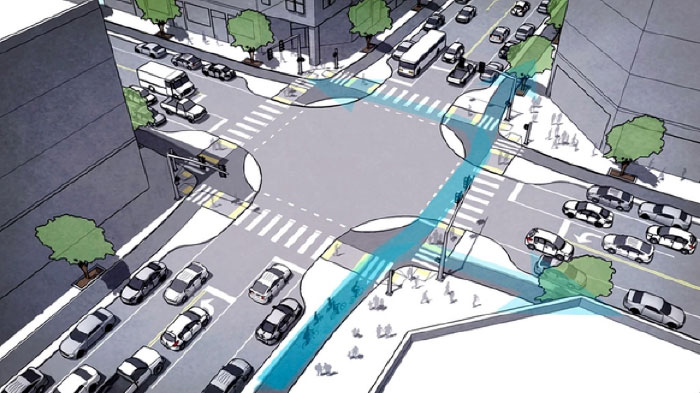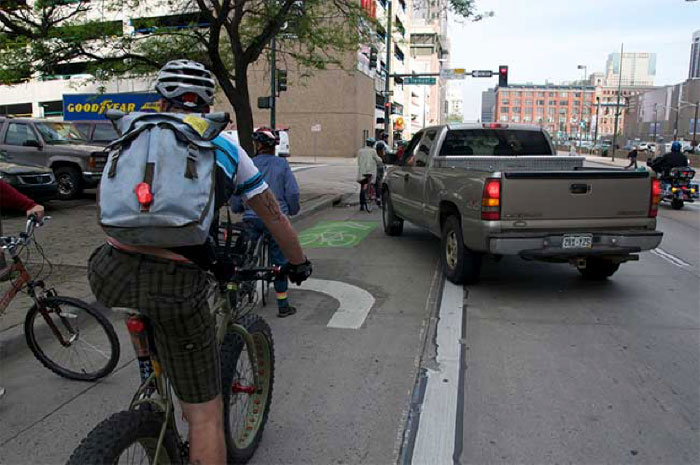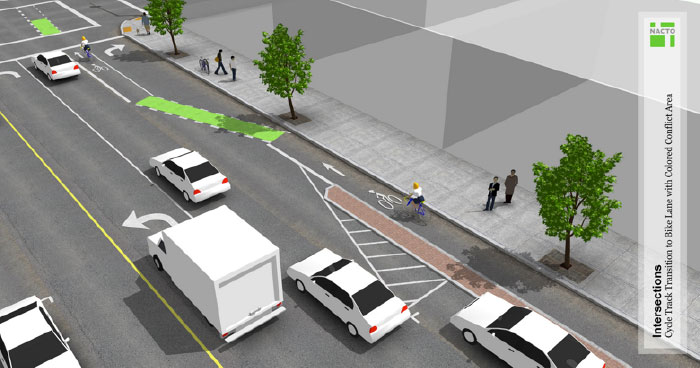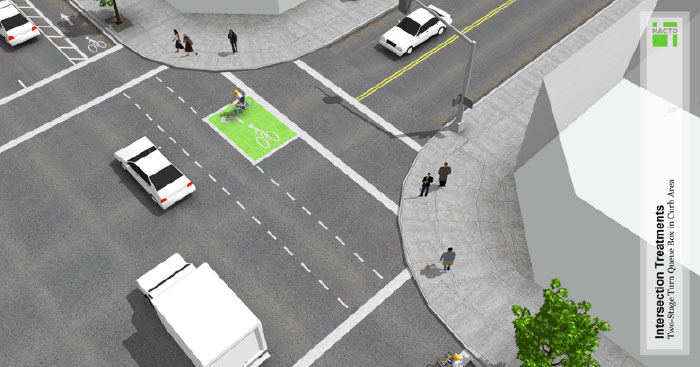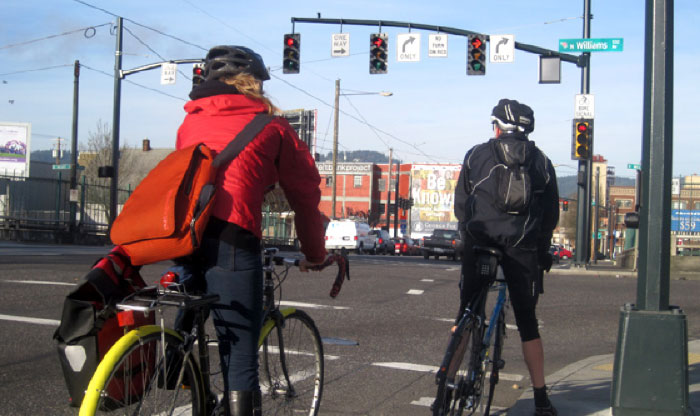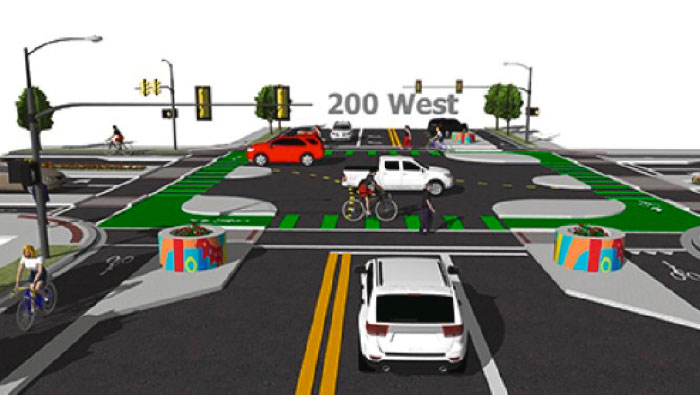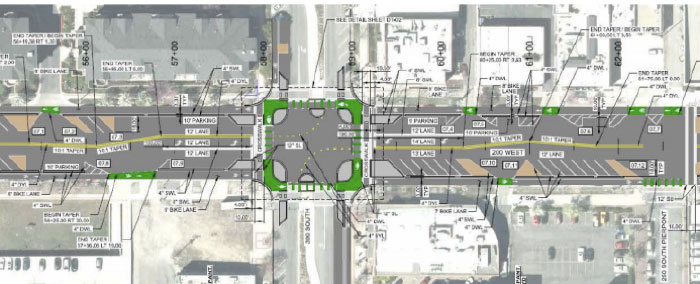As protected bike lanes become more common across the U.S., the way in which we design intersections is also evolving. American cities are on the cusp of implementing the nation’s first protected intersections, a potentially revolutionary approach to intersection design for bicycle safety. This post offers an overview of what constitutes a protected intersection, why they are being considered, and what opportunities and challenges exist for their implementation.
What is a Protected Intersection?
A protected intersection is a Dutch-inspired design treatment for protected bike lanes that is intended to minimize potential conflicts between people biking, driving, and walking. Protected intersections provide bicyclists physical separation through an entire intersection and eliminate stressful interactions with cars.
The concept behind a protected intersection was popularized by Mark Wagenbuur of Bicycle Dutch four years ago:
Nick Falbo, a bicycle consultant in the U.S., developed a similar video last year adapted for typical American streets:
Protected intersections include four main elements:
• A corner refuge island, which acts as a curb extension to provide bicyclists a secure refuge to wait at a red light and physically separates bicyclists as they make right turns.
• A forward stop bar, which improves visibility of bicyclists for drivers, provides a head start for bicyclists, and reduces exposure to cars.
• A setback bicycle and pedestrian crossing, which enhances reaction time for all users and allows drivers to cross at a perpendicular angle and slow speed for maximum visibility.
• Bicycle-friendly signal phasing, which allows for a leading bicycle interval, or in some circumstances, a dedicated bicycle phase.
How Do Protected Intersections Differ from Typical Designs?
Protected intersections seek to maintain a safe, low-stress bicycling experience that appeals to people not comfortable bicycling in mixed traffic or on unprotected bike lanes. Current designs for protected bike lanes drop the protection at intersections, creating an ambiguous and chaotic condition. Since a low-stress bicycling experience is only as strong as its weakest link and most conflicts and crashes occur at intersections, most of the treatments included in the NACTO Urban Bikeway Design Guide and other notable publications are inadequate by international standards.
Here’s a few examples of antiquated designs from the NACTO guide that Dutch cities phased out decades ago:
The cycle track-bike lane transition forces bicyclists to pop out into moving traffic and merge/weave across the right turn lane to an unprotected bike lane with traffic on both sides. This approach represents a high stress situation in which drivers and bicyclists are expected to make fast judgements with difficult sight lines, maximizing conflicts. This design, along with mixing zones, can be especially challenging when the speed differential is high as in the case of a proposal for Shoreline Blvd in Mountain View.
Cycle track bend-in approach (Source: NACTO)
The bend-in approach forces bicyclists to swerve closer to vehicles at intersections, reducing margin of error and increasing conflicts. The intent of this design is to bring bicyclists into the field of vision of drivers, but in practice, it doesn’t work very well. One example of the unsafe conflicts associated with the bend-in approach is in Missoula, Montana as described in this video. Ironically, Missoula’s problematic design is showcased on NACTO’s website.
For left turns, NACTO recommends unprotected two-stage left turn boxes, which require bicyclists to stop in the middle of an intersection to turn left. Two-stage turns present several challenges to bicyclists: they expose bicyclists in the middle of an intersection surrounded by vehicles on all sides. Compliance by bicyclists on two-stage turns isn’t always great for these reasons.
A dedicated bike signal phase is the only option currently accepted by American engineering guides that provides full protection to bicyclists, but this treatment also has its limitations. Dedicated signals can pose challenges to intersection operations because they lengthen cycle lengths and increase delay for all users. They typically require a dedicated right turn lane to accommodate right turn queues. As a result, they’re often only used in special circumstances.
In contrast to these treatments, protected intersections offer a safer and more secure experience riding through an intersection. Protected intersections eliminate the need to mix with cars. They allow bicyclists to easily make a right turn without entering automobile traffic, and a two-stage left turn without crossing against oncoming car traffic or sitting exposed in a two-stage left turn box. In the Netherlands, the result has been a more organized intersection with fewer conflicts between users.
Are Protected Intersections a “New” or “Innovative” idea?
Protected intersections are not a new or innovative idea. Dutch engineers have built protected intersections for over 40 years, and American engineers could have too. As Marc Caswell detailed on Streetsblog last month, Davis, CA and other cities came close to implementing protected intersections in 1972. Ultimately, design guidance by the Federal Highway Administration and other leading agencies settled on an incomplete solution that ignored protected bike lanes and the issue of intersections, bowing to pressure from a vocal minority of vehicular cyclists without a rigorous evaluation of options. These guides have remained relatively unchanged for decades.
What are the Challenges Associated with Protected Intersections?
Protected intersections aren’t necessarily a silver bullet. They face some key challenges that may limit their widespread implementation:
• Space constraints: Protected intersections may not always be possible given the space constraints of a street. Although current treatments are not desirable from a safety perspective, traffic engineers like them because they facilitate right turn lanes and can accommodate wide turns by large trucks. Protected intersections require a stronger prioritization of bicycling that may require the removal of a right turn lane, leading to longer vehicle queues. They may be also be difficult for fire trucks and other large vehicles to navigate around. These tradeoffs may not always present a workable solution.
• Vehicle speeds: While protected intersections may offer a safer design over typical treatments, right hook crashes remain a danger for vehicles turning at fast speeds. Tight corner radii are necessary for this reason, although these may be tricky depending on the design of the vehicle, as noted above. For intersections with two or more lanes, the tight corner radii are partially negated by the ability to turn into the inside lane, so it’s unclear how effective protected intersections will be in this circumstance.
• Behavior adjustment: as a new design, protected intersections necessitate a bit of a learning curve for all users. To function correctly, drivers must yield to bicyclists, bicyclists must yield to pedestrians, and pedestrians must avoid standing in the bikeway. Appropriate signage and pavement markings can help ease this transition.
• Cost: Protected intersections require more work to design and construct than simpler, more minimalist intersection treatments. This cost barrier may limit their widespread adoption in the short term since many protected bike lanes are implemented as low cost tactical urbanism projects.
Perhaps the biggest challenge associated with protected intersections, however, is their lack of support by key reference guides such as AASHTO, NACTO, and FHWA. While these guides have incorporated some more questionable intersection treatments (discussed above), they have been slow to embrace protected intersections. Most city engineers rely on these guides for approvals; they also provide backing in the event of a legal challenge. Without institutional backing, only a select few courageous cities will implement protected intersections.
Where are Protected Intersections being Implemented?
Several cities, including Salt Lake City, Austin, Davis, and Boston, are racing to install the nation’s first protected intersection. Salt Lake City is likely to have the first one installed this summer; by the end of the year, several may be up and running across the country. These projects will be closely watched by planners and engineers across the country: if successful, we can expect more cities and major design guides to adopt them as well.

